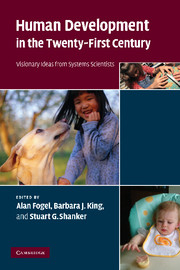Book contents
- Frontmatter
- Contents
- List of contributors
- Introduction: Why a dynamic systems approach to fostering human development?
- Part I Dynamic relationships between genetics and environments
- Part II The dynamic system of the child in the family
- 6 Relationships that support human development
- 7 The impact of emotions and the emotional impact of a child's first words
- 8 Emotional habits in brain and behavior: a window on personality development
- 9 Creating family love: an evolutionary perspective
- Part III The dynamic system of the child in social and physical environment
- Part IV Dynamic systems approaches to mental health
- Part V Conclusions and outlook
- Index
- References
6 - Relationships that support human development
Published online by Cambridge University Press: 22 September 2009
- Frontmatter
- Contents
- List of contributors
- Introduction: Why a dynamic systems approach to fostering human development?
- Part I Dynamic relationships between genetics and environments
- Part II The dynamic system of the child in the family
- 6 Relationships that support human development
- 7 The impact of emotions and the emotional impact of a child's first words
- 8 Emotional habits in brain and behavior: a window on personality development
- 9 Creating family love: an evolutionary perspective
- Part III The dynamic system of the child in social and physical environment
- Part IV Dynamic systems approaches to mental health
- Part V Conclusions and outlook
- Index
- References
Summary
When Susan was one-and-one-half years old, she had been playing the “lion game” with her mother for the past few months. With a lion puppet on her hand, Susan's mother made the lion roar, tickle, bite, and tease Susan, who seemed delighted to be aroused and frightened. Susan and her mother first concocted this curious blend of happiness and fear, approach and withdrawal, when they discovered tickling games. Susan was only six months old at the time. As her mother loomed in for the tickle, Susan would pull away, turn her body to the side, and at the same time reach out for her mother, look at her, and laugh heartily with her mouth wide open. From early in the first year, simple games create emotional challenges – such as a conflict between approach and withdrawal – that are negotiated in the long-term parent–infant relationship.
Emotions are good for us, a kind of psychological workout. Joy, fear, surprise, and sadness move us internally, shifting our body chemistry and lighting up our brains. Babies are more emotionally alive than most adults: they feel and respond to everything. As people leave infancy behind, however, they learn not to feel as much or as intensely. People who are repeatedly left alone as children, for instance, experience powerful fear and sadness during the separation. Without someone present to whom a child can turn to relieve them, these emotions had to be suppressed because they would be too overwhelming.
- Type
- Chapter
- Information
- Human Development in the Twenty-First CenturyVisionary Ideas from Systems Scientists, pp. 57 - 64Publisher: Cambridge University PressPrint publication year: 2007



